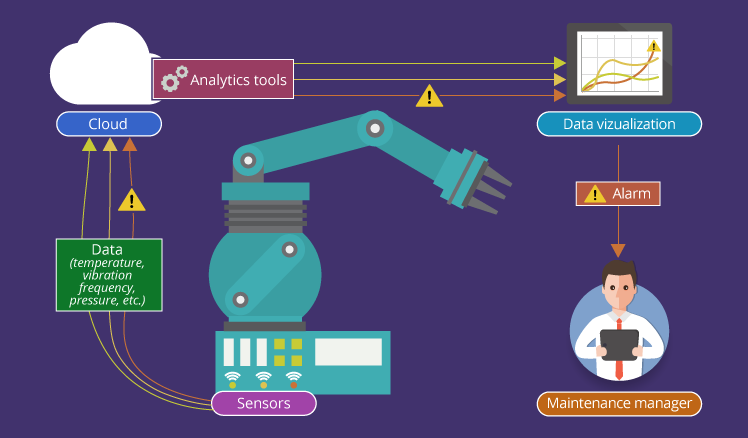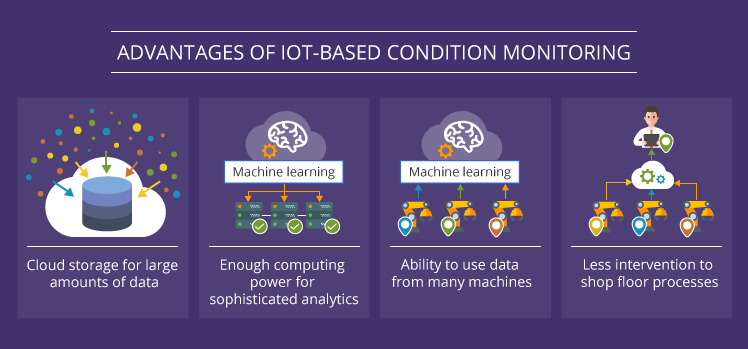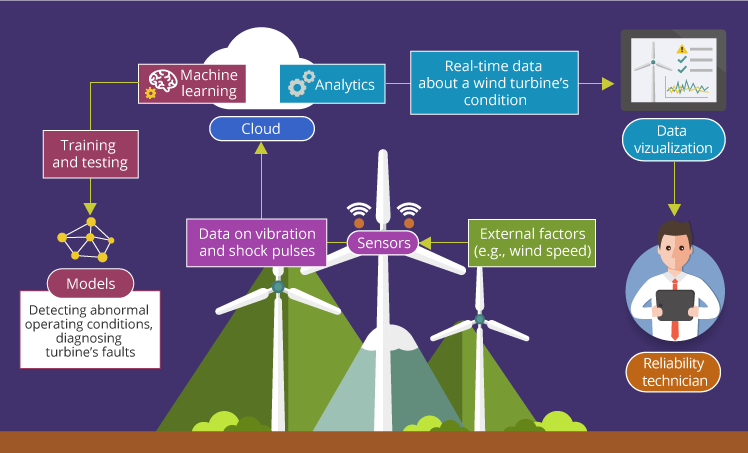How IIoT transforms condition monitoring
The research states that 82% of companies have experienced unplanned downtime over the last three years. Considering the fact that it can cost a company as much as $260,000 an hour, unplanned downtime is something companies are striving to steer clear of. Another research states that 64% of unplanned downtime is related to equipment failures, which arise from improper maintenance, overrunning machines and a lack of efficient machines’ condition tracking.
Fortunately, with modern technologies (read IIoT), manufacturers can monitor the condition of machines in real time to predict malfunctions and schedule service maintenance ahead of an actual failure. In this article, we’ll reveal top points manufacturers need to know to effectively leverage IoT solutions for condition monitoring.

Approach
A condition monitoring solution enabled by the industrial IoT is carried out in the following way.
An industrial machine gets equipped with sensors, which collect the data on a wide range of variables that determine its health and performance, for instance, temperature, vibration frequency, pressure. Once collected, the data is passed over to the cloud. The cloud software aggregates the data from sensors and applies analytics tools to develop time-series sensor data into informative insights about equipment’s health and operational parameters. A condition monitoring solution visualizes the findings and communicates them to the users in a comprehensive form, say, as charts or diagrams. In case the situation deviates from the norm, a condition monitoring solution can also send an alert to a maintenance manager, notifying them about deterioration of equipment’s condition.
The data fetched by a condition monitoring solution provides valuable insights about the current state of equipment and can be applied to indirectly monitor the quality of goods in production – through monitoring the state of equipment’s components. For example, in paper manufacturing, condition monitoring solutions help to monitor the quality of paper being produced through monitoring the condition of roll presses.
But the usefulness of condition monitoring is not limited to quality control. Its findings can be used to forecast future equipment performance, anticipate which equipment components are likely to fail – and decide on the scope of maintenance activities based on the predicted level of degradation (in other words, carry out predictive maintenance.)
Applications
Condition monitoring can be applied across a wide range of industries. Below, we list just a few most frequent examples:
- Discrete manufacturing
In the automotive industry, for instance, manufacturers turn to IoT development to track the state of welding machines, spindles in milling machines, laser drilling machines, etc. This equipment is difficult to reach for manual inspection, while an IoT-based condition monitoring solution offers an opportunity to monitor machines’ condition without physical access to them. Moreover, an IoT-based condition monitoring solution helps to identify early-stage defects including cracking, spalling, lubrication problems, misalignment of assembled parts, etc. in real time. Our smart factory demo showcases, how condition monitoring can be used in this industry.
- Process manufacturing
In the steel industry, condition monitoring can be applied to monitor the state of cold rolling mills, particularly critical for the quality of steel and difficult to inspect with portable instruments. Early recognition of rolling mills’ defects allows manufacturers to timely take corrective actions and minimize the negative impact to the output product.
In pulp and paper industry, condition monitoring is applied to track the condition and the alignment of rolls and roll balance. For that, sensors collect the data on vibration and temperature and transmit it to the cloud for analysis.
- Upstream oil and gas
The ability to monitor offshore drillings in real time from a single location is the reason upstream oil and gas companies turn to Industrial IoT development. They roll out IoT-enabled solutions to monitor the condition of drilling equipment, pressure vessels, storage tanks, pipelines, etc. For that, a network of sensors is deployed to collect the data about drilling rigs condition. Once the data is processed, the condition monitoring solution is able to identify the equipment in the potentially critical state. Additionally, drilling rigs deploy high sensitivity IR cameras to monitor pipeline leakages by detecting differences in temperatures.
- Electric power
Condition monitoring allows power plants to ensure reliable power generation. In the electric power industry, it is applied to track the health of coal-fed steam turbines, wind turbines, gas turbines, electrical substations and even nuclear power plants. With vibration and pulse shock sensors, it is possible to monitor the condition of, for example, a turbine’s rotating parts, cages and gearbox bearings.
- Construction
IoT-based condition monitoring is widely applied to track the health and operating parameters of heavy machinery. With oil analysis, for instance, it is possible to monitor the state of a combustion engine and identify early-stage problems. For example, the increased contents of iron signals about engine deterioration, while the combination of iron, aluminum and chrome may signal about upper cylinder wear.
Advantages
By consolidating and analyzing the data about the health and performance of machinery and making the insights available in real time on the desktops or in mobile apps of reliability technicians, IoT-based condition monitoring provides a solid foundation for process and business optimization. To be more specific, IoT provides the following advantages:
- Cloud storage for large amounts of data
Storing data on-premises, a manufacturer requires a data center with several dedicated servers to collect and process sensor data. As a result, the amount of data that can be stored is limited to the local data center’s storage capabilities. Moreover, in many cases the distributed nature of manufacturing facilities (as in oil & gas industry, for instance) does not allow putting a date center close to the equipment to be monitored. IoT, on the other hand, leverages cloud computing, which allows storing huge amounts of data in the cloud. It is particularly important considering the volume of data generated by connected machines. Just one wind turbine, for instance, takes 2,000 readings per minute, which makes about 1 terabyte of data a week. Leveraging Industrial IoT, manufacturers can store vast volumes of data and scale storage capacity.
- Enough computing power for sophisticated analytics
In case condition monitoring is performed for the purpose of predictive maintenance, an IoT-based condition monitoring solution applies machine learning algorithms to draw the conclusions about equipment’s health, as well as improve diagnostic accuracy. However, machine learning is a CPU intensive process, which requires enough computing power and parallel processing with several machines working in cluster. A cloud-based condition monitoring solution provides enough computational resources to run machine learning algorithms.
- Ability to use data from many machines
Machine learning algorithms require a significant amount of data. For instance, to train a predictive model that identifies vibration values leading to cracking of welding machines’ spindles, the data about a hundred cracking cases is needed. With the data from one machine, gathering the required amount of data would take years. On the other hand, gathering the data from several welding machines simultaneously, a data scientist can collect the required amount in about a year. Moreover, the diversity of data fetched from several physical locations increases the accuracy and improves the functionality of predictive models.
- Less intervention to shop floor processes
IIoT offers an opportunity to intelligently monitor hundreds of industrial machines from a single location without physical access to them. It is especially relevant for such industries, as, for example, electric power and oil & gas since it makes it easier to monitor remote installations, including pipelines and offshore drilling rigs. The data about the health and the performance of the equipment is collected, aggregated and relayed to the cloud for processing. The cloud analyzes the data and displays the results to the reliability technicians anywhere in the enterprise.

A success story
Let’s have a look at the example of a successful condition monitoring solution implementation. In the wind power industry, IoT-based condition monitoring solutions are frequently applied to monitor the state of wind turbines, since their components are particularly exposed to failures. For that, a turbine’s gearbox and rolling bearings get equipped with vibration sensors to detect gear defects and bearing wear.
In case vibration sensors’ readings are strongly influenced by external factors, vibration analysis alone is not enough to give reliable information about the state of a wind turbine. In such case, additional shock pulse sensors are attached to the bearing components.
The sensors collect the data on vibration and shock pulses to pass it over it to the cloud. The cloud aggregates the data and analyzes it to develop sensor readings into informative insights about the condition of a turbine. The real-time data about a wind turbine’s condition is visualized and displayed to the reliability technicians.
Since the accuracy of sensor readings can be influenced by external factors, say, high wind speed, a condition monitoring solution needs to be able to differentiate between true alarming parameters and false positive factors. For that, machine learning algorithms are applied to the condition, operational, maintenance and environmental data collected over a period of time, say, a year. By the end of the training and testing, a machine learning model is able to differentiate between normal and abnormal operating conditions, as well as diagnose turbine’s faults within dynamic operating parameters. It helps to avoid false alarms caused by an increase in signal strength due to external factors.

A short recap
The primary purpose of condition monitoring is ensuring uninterrupted and efficient equipment functioning. Condition monitoring can either be leveraged independently, providing reliable information about the current state of industrial machines, or serve as a springboard to predictive maintenance.
Implementing a condition monitoring solution, it’s better to opt for IoT technologies, since IoT offers the possibility to store large amounts of diverse data. IoT solutions also allow to monitor the condition of the machines remotely. Moreover, IoT-driven solutions provide enough computing power to run robust machine learning algorithms for the purpose of predictive maintenance. As a result, IoT-based condition monitoring allows to decrease unplanned downtime and eliminate shutdowns by as much as 75%.

